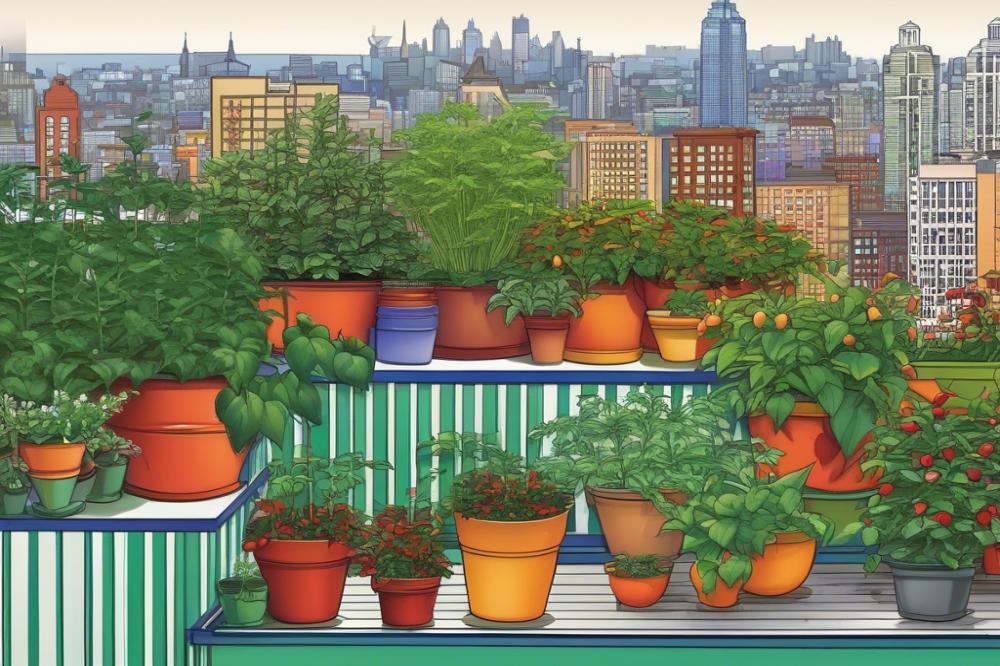The Art of Growing Bird’s Eye Chili in Small Spaces
Urban gardening has gained immense popularity in recent years. People are eager to cultivate fresh produce right from their balconies, patios, or even kitchen windowsills. One delightful plant that fits perfectly in these limited areas is the Bird’s Eye Chili. Known for its fiery flavor and vibrant appearance, this chili is a favorite in many culinary dishes. It adds a spicy kick to meals and is esteemed in diverse cuisines around the world.
container gardening provides excellent opportunities for those with minimal outdoor space. Pots or containers allow chili planting without the need for a sprawling garden. This method makes it easier to control growing conditions. You can adapt soil requirements, choose the right watering schedule, and monitor light requirements based on your specific location. Additionally, small space gardening is highly rewarding, giving you the chance to nurture and harvest your own produce, even in an urban environment.
Growing chili peppers in containers brings many benefits. Not only can you manage soil quality closely, but you also have the flexibility to move the plants as needed. If a spot doesn’t get enough sunlight, simply shift the container to a sunnier area. Moreover, these plants can enhance the aesthetic appeal of any small space. Imagine vibrant green leaves and bright red or green chilies adorning your balcony!
Several gardening tips can help ensure successful growth. Pay attention to temperature tolerance, as Bird’s Eye Chili thrives in warm weather. Start the seeds indoors if chilly evenings are common in your area. Choose good-quality potting mix, rich in nutrients, for your containers. Always remember to follow a consistent watering schedule to keep the soil moist but not soggy. With care and attention, you can enjoy the thrill of watching these little peppers flourish despite your limited gardening area.
Understanding Bird’s Eye Chili


The Bird’s Eye Chili is a small, yet fiery member of the chili family. It is known for its intense heat and vibrant flavor. This variety typically measures between 50,000 to 100,000 on the Scoville scale. People who enjoy spicy dishes appreciate its ability to add a punch to recipes. The heat hits quickly on the palate, followed by a fruity and slightly sweet taste that balances the spice. Many culinary enthusiasts love using these chilies in sauces, stir-fries, and marinades.
This chili originates from Southeast Asia, where it forms a key ingredient in many regional dishes. Countries like Thailand, Vietnam, and Indonesia showcase the chili’s versatility. In addition to its culinary uses, it adds visual appeal to any garden. The vibrant red, orange, or green pods are perfect for urban gardening or container gardening. Enthusiasts often enjoy the sight and the challenge of growing this plant.
Growing Bird’s Eye Chili in home gardens can be rewarding. The plant prefers full sun, requiring at least six hours of bright light each day. When considering soil requirements, opt for well-draining, fertile soil. A mix of potting soil combined with compost works best to allow for good drainage. Watering requires attention too. A consistent schedule is vital: the soil should remain moist but not soggy. Overwatering can stunt growth and lead to root rot.
Tips for chili planting include starting seeds indoors if you live in cooler climates. This allows for an early start. Once seedlings develop a few true leaves, you can transfer them to larger containers or outdoors. Ensure you choose pots that provide ample space. These plants thrive and can reach heights of two to four feet, further emphasizing their ornamental value.
Besides being a staple for cooking, this chili thrives in a home garden for many reasons. The plant attracts beneficial insects, which can help in pest control. Home gardening also brings the joy of nurturing and harvesting something fresh. It enhances meals with home-grown flavor and spice while also beautifying any small space. Enjoy the journey of growing this delightful pepper variety.
Container Gardening Essentials


Container gardening is an excellent choice for those interested in growing Bird’s Eye Chili in limited spaces. The flexibility of containers allows you to manage your plants more easily. urban gardening often means limited yard space, making pots and containers essential. Easily movable, containers can catch sunlight better and provide plants with the warmth they need. Plus, you can tailor the soil requirements for each plant, offering optimal growing conditions.
When it comes to selecting containers, several options work well. Plastic, terracotta, and ceramic are popular materials. Each material has its pros and cons. Terracotta offers breathability but can dry out quickly. Plastic is lightweight and retains moisture, but it might not be as visually pleasing. Pick a size that suits the roots of the chili plant—usually anywhere from 2 to 5 gallons will suffice. Using a larger container can encourage bushier growth and yield more fruit.
Arranging your containers in a small space requires some thought. Grouping pots together can create a mini garden look while saving room. Placing taller plants behind smaller ones allows better access to sunlight. Consider using shelves or vertical stands if you want to maximize your vertical space. This method also adds an aesthetic flair to your home gardening project. Keep in mind the light requirements for each container while deciding where to place them. Chili plants thrive best in bright, direct sunlight, so positioning them effectively is vital.
Watering is another crucial element to monitor. A consistent watering schedule helps the plants grow well. Over-watering or under-watering can be detrimental. Consider using self-watering pots to make this task easier. These containers will help regulate moisture levels, providing the plants with just the right amount of water. For soil, use a good-quality potting mix with excellent drainage. This ensures nutrients are available while preventing root rot.
Don’t overlook the culinary uses of the peppers you’ll grow. Many people find joy in adding a personal touch to their meals with home-grown ingredients. Each plant can produce numerous small, spicy chilies, perfect for salsas, sauces, or garnishes. Engaging with this garden project brings not only fresh peppers but also a sense of accomplishment. Follow these gardening tips to make the most out of your small-space gardening adventure.
Optimal Growing Conditions


Bird’s eye chili thrives under specific conditions that can make a significant difference in its growth and flavor. The right soil is essential for success in container gardening and overall health. Ideally, the soil should be rich in organic matter with good drainage. A mix of potting soil, compost, and perlite can create a suitable base for chili planting.
Soil pH plays a crucial role. The ideal range is between 6.0 and 7.0. This slightly acidic to neutral range supports nutrient uptake. Nutrient content matters greatly, too. High levels of nitrogen, phosphorus, and potassium contribute to robust plant growth. Home gardening practices can often involve testing soil to maintain balanced nutrients.
Good drainage is vital when growing in containers. Waterlogged soil leads to root rot, which can quickly destroy the plant. Ensure that your pots have drainage holes. Fill the bottom with gravel or stones to help out. This layer allows excess water to escape, promoting healthy roots.
Light requirements are equally important for a thriving plant. Aim for at least six hours of direct sunlight each day. Choosing a south-facing window or outdoor spot that receives ample sun is recommended. Indoor gardening often requires supplemental grow lights if natural sunlight is insufficient.
Pay attention to your watering schedule. Consistent but not excessive watering encourages the plant to develop strong roots. The top inch of soil should dry out before adding more water. Remember, the seasons may influence how often you need to water.
Urban gardening can bring its own set of challenges, but with the right attention, growing conditions can be optimized. When caring for your plant, consider the culinarily rich uses of the fruit. A successful crop enhances meals with a burst of flavor, making every effort worthwhile.
Light and Watering Requirements


The Bird’s Eye Chili thrives under plenty of sunlight. Aim for at least six hours of direct sunlight each day. If you’re doing container gardening, consider placing pots in a south-facing area. That location helps to maximize exposure to the sun. It’s important to keep windows and walls in mind too. Bright indoor spaces can also work if outdoor light isn’t accessible.
Watering is just as crucial. Maintain a consistent watering schedule to support healthy growth. Soil should be kept moist but never soggy. Overwatering can lead to root rot, which is detrimental to the plant. Signs of too much water include yellowing leaves and a mushy stem. On the other hand, underwatering is also a concern. If leaves start curling or turning brown, your chili may need more water.
Always check the soil before you water. Stick your finger about an inch into the mix. If it feels dry at that depth, it’s time for a drink. Good gardening tips include adjusting your watering routine based on the season. Warm months often require more frequent watering. Monitor your plants closely, especially during heat waves. Adapting to growing conditions is vital for success in home gardening.
Regarding soil requirements, a well-draining mix works best. This setup prevents standing water around the roots. Combining potting soil with perlite promotes drainage. Ultimately, understanding both light and water needs helps to foster healthy plants ready for culinary uses. Focus on these aspects, and your chili plant may thrive beautifully in your urban gardening setup.
Gardening Tips for Success
Growing chili in small spaces can be quite rewarding. To make the most of your limited area, container gardening is a practical option. Choose pots that are at least 5 gallons in size to provide enough room for the roots to thrive. When considering soil, select a well-draining potting mix. Aim for a blend that retains moisture but allows excess water to escape. This is crucial for healthy plant growth.
Pest control is another important aspect of successful gardening. Regularly inspect your plants for common pests like aphids or spider mites. If you encounter any, use a mild soap solution to treat your plants. Spraying this mixture once a week can help keep these nuisances at bay. Utilizing companion planting can also deter pests. Planting basil or marigolds nearby may repel harmful insects.
Fertilization plays a key role in the happiness of your chilis. Start with a balanced fertilizer during the early stages of growth. Transition to a fertilizer high in potassium when the flowers appear. This change supports fruit development and boosts the flavor of your harvest. Be mindful, though, of over-fertilizing. Excess nutrients can harm the plants instead of helping them flourish.
A consistent watering schedule is vital for your peppers. Water your plants deeply once a week, allowing the soil to dry slightly between watering sessions. Overwatering can lead to root rot, a common issue in container gardening. Try using a moisture meter to check the soil’s dryness before giving more water. Keeping an eye on your plants will help you understand their needs better.
Light requirements should not be overlooked when growing chilis. These plants thrive in full sunlight, needing at least 6-8 hours of direct light each day. If you’re in an urban gardening setting, consider placing your containers on a balcony or rooftop garden where they can catch plenty of sun. For areas with less sunlight, using grow lights can supplement natural light, helping your plants grow strong.
Pruning is another essential practice. Snipping off the lower leaves can improve air circulation and focus the plant’s energy on producing fruits. Additionally, removing any dead or yellowing leaves can prevent disease. Regularly shaping your plants can lead to a healthier harvest.
Common challenges include dealing with fluctuating temperatures. If nights become too cold, bring your containers indoors. A stable environment promotes growth and fruit set. Also, watch for signs of stress, like wilting or discoloration. These signals may prompt you to adjust your watering or light conditions.
With these gardening tips, you’ll create a thriving environment for your chili planting adventure. Remember to keep your approach flexible and responsive to your plants’ needs. Enjoy the journey of home gardening as you nurture your crops!
Culinary Uses and Harvesting
Bird’s Eye Chili adds an exciting kick to various dishes. Chefs around the globe appreciate its spicy flavor and vibrant red color. When cooking, these small chilies can be sliced and added to stir-fries, soups, and sauces. They mix well with other ingredients like garlic, ginger, and fresh herbs. In many Asian cuisines, they are essential for enhancing flavor. Use them in marinades or salsas for a fiery twist. Always remember, a little goes a long way with these potent peppers.
Harvesting chilies at the right time is crucial to enjoying their full flavor. Most peppers develop into deep green before transitioning to bright red. Picking them at the red stage offers maximum heat and sweetness. Grab scissors or pruning shears to harvest for the best results. Such tools prevent damage to the plant and allow clean cuts. A good tip is to check for firmness before harvesting; if they feel solid, they are likely ready to be picked.
Timing for harvesting should be within a specific window. Picking too early means missing out on the rich and complex flavors. Late-season harvesting can lead to overripe fruit that falls off the plant. Monitor the plant closely as the season progresses. A consistent watering schedule will help the plant thrive. The right growing conditions, along with proper soil requirements—like well-draining soil—will set you up for success.
Bright sunlight is essential for the optimal growth of your plants. Nearly six to eight hours of direct sun is ideal. Urban gardening often offers limited light, so plan your container gardening accordingly. Rotate pots to maximize light exposure. Keeping an eye on the overall health of your plants is also necessary. Look for any pests or diseases that could interfere with the harvest.
Integrating Bird’s Eye Chili into meals can also be done creatively. Think about adding chopped chilies to salads for a zesty punch. You might consider making chili-infused oil, which is great for drizzling on finished dishes. Dried chilies can serve as a seasoning; grind them into flakes for an easy spice that elevates meals. Exploring different recipes can bring delightful surprises to your cooking repertoire. The world of culinary uses for this chili is vast, so feel free to experiment.
Final Thoughts
Growing your own fiery chilis in limited spaces can be quite rewarding. The art of cultivating these little gems not only brings excitement but also engages you with nature. Embracing urban gardening opens up opportunities for those with small balconies, patios, or even window sills. Container gardening allows for creativity, as you can choose pots that complement your space while offering the right environment for growth.
Experience the joy of watching your plants thrive under your care. Each day brings a chance to check your progress and marvel at the vibrant colors that emerge. The satisfaction of harvesting and using your chilis in culinary creations cannot be understated. Imagining the flavors added to your favorite dishes transforms cooking into a delightful adventure.
Take the tips shared throughout this article and put them into action. Gathering the right tools is crucial, but so is a little patience. Committing time and care to your plants can yield impressive results. Every effort you make contributes to the joy of home gardening.
Feel inspired to start your own chili-growing journey. Just envision the taste of freshly harvested chilis enhancing your meals. Let your small space flourish and enjoy the fruits of your labor. Happy gardening!



